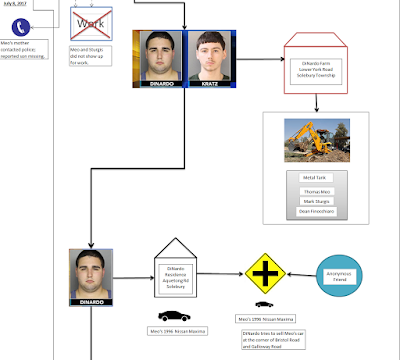Three years ago, four
young men were murdered in Bucks County, Pennsylvania. I wrote about this case and created an
illustrated timeline in my crime blog, Caroline's Chronicles of Crime. The Investigation Discovery Channel produced a short documentary on the
incidents. These crimes happened within
miles of my home. It was surreal for my
parents to see someone from the gym mourning her son on the television screen.
The young lives that were
cut short were portrayed as purely innocent despite that the murderous
conflicts involved drugs. Anyone
murdered becomes innocent regardless of their past. However, I can not help but wonder if this
case happened a few miles away in Philadelphia and everyone involved was
African American, would the media portray the black victims in the same light? Would the case have been turned into an
hour-long feature on Investigation Discovery?
The white skinned serial
killer, Cosmo DiNardo, murdered four white males, but had DiNardo and his four
victims been people of color, would the story have been told differently on the
news? No one is calling the case, “white-on-white
crime!”
The sad reality that is
somewhat taboo is that the murder victims were attempting to buy marijuana in
wholesale amounts. Since marijuana has a
reputation as a soft drug, it is possible that the victims did not perceive the
business to be as dangerous as dealing heroin or cocaine. The victims most likely wanted to make some
extra cash from selling it to friends.
Jimi Patrick, who was college bound, probably intended to make a few
sales and become popular with partiers in his first semester. Although it is saddening for these men to be
brutally and coldly murdered, the victims were not perfectly innocent
lambs. If the victims were black men
from North Philly, the wording would be changed in the columns. Instead of “Four murdered in Bucks County,”
the headline would probably read, “Four Drug Dealers Killed by Philadelphia
Drug Lord.”
Regarding the victims, Jimi
Patrick was straight-laced and clean cut with no criminal record, but Dean
Finocchiaro was a rowdy boy who had a few run-ins with the cops for
joy-riding. The ID program treated his
past as forgivable, and his father said he was “just a little immature.” If Dean were African American, would the
media downplay his rap sheet? Would he
be just a mischievous kid or would he be painted as a juvenile delinquent whose
life led him to a deadly drug deal?
Don’t get me wrong. These were horrific crimes no matter who fell
victim. Cosmo drove a tractor over
Thomas Meo’s body while he was still alive!
Cosmo ran out of bullets and intended to stop Meo’s screams so distant neighbors
could not hear. Meo was paralyzed from
the waist down from being shot, and there was nothing he could do but curse as
he was run over. He died next to his
friend, Mark Sturgis, who was shot multiple times. Cosmo DiNardo morbidly premeditated the
murders, telling by how calculated his cover up scheme was. He used the family’s backhoe to bury three of
the victims six feet deep in a large, metal pig roaster. Cosmo and his accomplice cousin, Sean Kratz,
perpetrated the murders on an isolated estate belonging to their affluent
family.
Despite the fact that
everyone involved was Caucasian, privilege still played a role due to
socioeconomic differences. The murderer,
Cosmo DiNardo, came from a wealthy family who owned a cement contracting
business. All four murders took place on
DiNardo’s second property, a farm in Solebury Township. When Cosmo was first taken into custody,
Daddy DiNardo posted his $100,000 bail, setting a suspected murderer free to
roam.
The last time Dean Finocchiaro
spoke to his father, he said he would be “back in 15 minutes.” I believe he was telling the truth. Surveillance showed DiNardo’s silver Ford pickup
truck driving away. Drug transactions
take a few minutes in a parked vehicle, but Cosmo had other plans for him. DiNardo probably suggested on driving to a
separate location for the transaction or that the marijuana was kept at the
farm. In less than 15 minutes, Dean was
gone, and all his father would have were memories.
It’s vicariously
heartbreaking to see the surviving parents grieve as they tell their
stories. Though do we get to share the
heartache of black parents who mourn their late sons lost to drug and gang
violence? It doesn’t matter if it
happens more often in one neighborhood or another. Murder victims are human beings regardless of
skin color, and their surviving families feel just as much agony. At the end of the documentary, Mrs. Sturgis
said she wished she could pick up Mark’s dirty socks one more time. Don’t black mothers want to pick up those
socks one more time too?

No comments:
Post a Comment
Note: Only a member of this blog may post a comment.